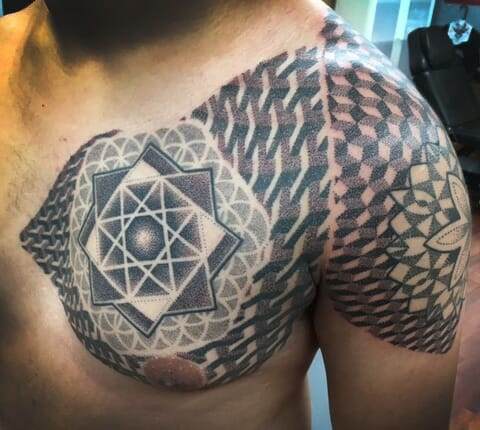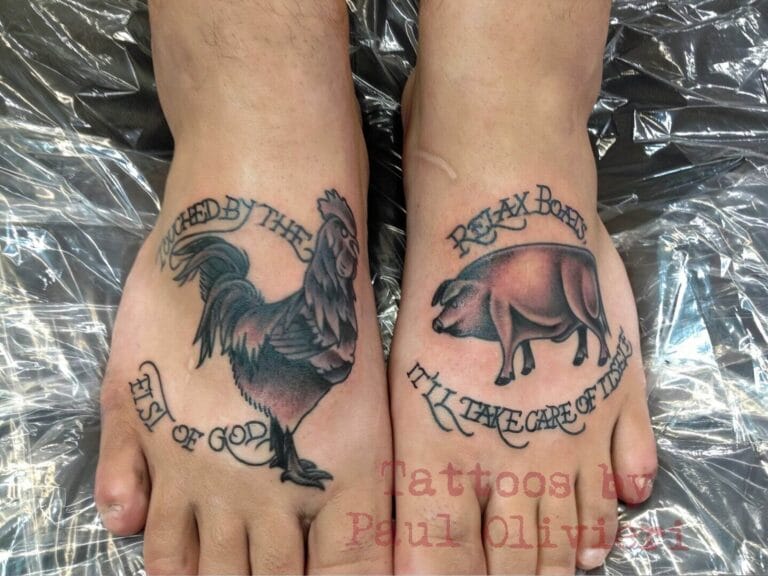
Introduction
Tattoos have been a popular form of body art for centuries, allowing individuals to express their individuality and creativity. Among the various styles and designs, geometric and mandala tattoos have gained immense popularity in recent years. These tattoos showcase intricate patterns and symmetrical shapes, creating a mesmerizing visual effect. They can be found on various parts of the body, such as the arms, back, or even on the face.
The beauty of Geometric & Mandala Tattoos
Geometric tattoos are known for their precise lines and mathematical shapes. These tattoos often feature triangles, circles, or polygons arranged in symmetrical patterns. The clean and sharp lines create a bold and striking appearance. On the other hand, mandala tattoos are inspired by the sacred geometry and spiritual symbolism of traditional Hindu and Buddhist art. They typically consist of a central point surrounded by intricate patterns, forming a mesmerizing circular design. The intricate details and symmetry of these tattoos make them visually appealing and captivating.
The influence of Math in Tattoo artistry
Mathematics plays a significant role in the creation of geometric and mandala tattoos. Tattoo artists utilize mathematical principles, such as symmetry, grid patterns, and proportion, to ensure the precision and balance of the design. They meticulously calculate angles and measurements to create harmonious compositions that flow with the contours of the body. This mathematical element adds a level of complexity and sophistication to these tattoos, elevating them from mere body art to a form of artistic expression.
In conclusion, geometric and mandala tattoos have captivated the hearts of many tattoo enthusiasts due to their mesmerizing designs and mathematical precision. Whether it’s the symmetrical patterns of a geometric tattoo or the spiritual symbolism of a mandala tattoo, these intricate designs are a testament to the creativity and skill of tattoo artists. So, if you’re looking for a tattoo that combines aesthetics with mathematical precision, geometric and mandala tattoos are worth considering.
Understanding Geometric Tattoos
Geometric Tattoo designs and symbolism
Geometric tattoos have become increasingly popular in recent years due to their unique designs and symbolism. These tattoos feature precise lines and mathematical shapes, such as triangles, circles, and polygons, arranged in symmetrical patterns. The geometric patterns used in these tattoos have various meanings and symbolism, depending on the design and the individual getting the tattoo. Some common interpretations include:
- The triangle symbolizes balance, harmony, and the trinity.
- The circle represents unity, eternity, and wholeness.
- The hexagon stands for balance and connection to nature.
- The square represents stability and practicality.
Each geometric design holds its own significance and can be chosen based on personal meaning or aesthetic preference.
The precision and symmetry of Geometric Tattoos

The beauty of geometric tattoos lies in their precision and symmetry. Tattoo artists utilize mathematical principles such as symmetry, grid patterns, and proportion to create these precise designs. They carefully calculate angles and measurements to ensure that the tattoo fits the body’s contours perfectly. The clean and sharp lines used in geometric tattoos create a bold and striking appearance.
The precise execution of geometric tattoos requires skill and attention to detail from the tattoo artist. They meticulously plan and execute the design to guarantee that each line and shape is perfectly aligned. This meticulous approach ensures that the tattoo maintains its geometric integrity and visual impact.
In conclusion, geometric tattoos have gained popularity for their unique designs and symbolic meanings. The precision and symmetry of these tattoos attract individuals looking for a bold and striking body art. Whether one chooses a simple triangle or an intricate pattern, geometric tattoos are an excellent choice for those seeking a precise and visually appealing design.
Exploring Mandala Tattoos
Meaning and significance of Mandala Tattoos
Mandala tattoos have garnered attention in recent years due to their intricate patterns and spiritual symbolism. The word “mandala” comes from ancient Sanskrit, meaning “circle” or “center.” These tattoos are typically circular in shape and feature a symmetrical design, consisting of various shapes, patterns, and symbols. The circular nature of mandalas represents the universe and the interconnectedness of all things. Mandalas also hold deep spiritual and cultural meanings across different traditions.
Intricate patterns and spiritual symbolism
One of the distinguishing features of mandala tattoos is the intricate patterns that make up the design. These intricate patterns often incorporate geometric shapes, floral elements, and sacred symbols, such as lotus flowers, elephants, or religious deities. Each element within the mandala holds its own significance and represents different aspects of life, spirituality, and personal growth.
Mandala tattoos also carry spiritual symbolism. They are often used as a tool for meditation and self-reflection. The act of creating or contemplating a mandala is believed to bring about a sense of inner peace and harmony. The combination of intricate patterns and spiritual symbolism makes mandala tattoos a popular choice for individuals seeking a meaningful and visually appealing design.
In conclusion, mandala tattoos offer a unique and visually stunning option for body art enthusiasts. The intricate patterns and spiritual symbolism behind these tattoos make them a popular choice among those seeking to express deeper meanings and connect with their spiritual side. Whether one chooses a smaller, discreet mandala or an elaborate, larger design, mandala tattoos offer a powerful way to showcase artistry and personal beliefs.
The Intersection of Math and Artistry
How Math Principles Enhance Tattoo Designs
Mandala tattoos are not only visually stunning but also incorporate mathematical principles to enhance their design. These principles include symmetry, balance, and geometric shapes. By using these mathematical concepts, tattoo artists can create intricate and visually appealing designs that captivate the eye.
The symmetry of mandala tattoos plays a crucial role in their overall aesthetic. Symmetry refers to the balance and harmony achieved when both sides of a design are mirrored. The use of symmetrical patterns in tattoo designs creates a sense of equilibrium and visually pleasing compositions.
Geometric shapes are a common element in mandala tattoos. These shapes, such as triangles, circles, and squares, are naturally pleasing to the eye and add a sense of order to the overall design. The precise calculations and measurements involved in incorporating these shapes into the tattoo ensure that the final result is symmetrical and balanced.
The Symmetry and Balance in Geometric & Mandala Tattoos

The combination of symmetry and balance in geometric and mandala tattoos contributes to their visual impact. The precise measurements and calculations involved in creating symmetrical designs make these tattoos visually striking and aesthetically pleasing to the eye.
Moreover, the use of the mandala pattern adds a spiritual and symbolic depth to the tattoo. The circular shape represents wholeness, unity, and the interconnectedness of all things. The intricate details within the circular design represent different aspects of life, spirituality, and personal growth.
In conclusion, the intersection of math and artistry is evident in the creation of mandala tattoos. By incorporating mathematical principles such as symmetry and balance, tattoo artists can enhance the beauty and impact of these tattoos. Whether one is drawn to the spiritual symbolism or the visual appeal of mandala tattoos, they serve as a unique and powerful form of self-expression.
Popular Geometric Tattoo Designs
Triangle, Square, and Hexagon Tattoos
Triangle, square, and hexagon tattoos are among the popular choices for those looking for geometric designs. These shapes are not only visually appealing but also hold symbolic meanings.
The triangle, for example, is often associated with balance and harmony. It can represent the three fundamental forces of nature – earth, water, and air. Additionally, each side of a triangle can symbolize different aspects of life, such as mind, body, and spirit.
Square tattoos, on the other hand, represent stability and foundation. The four equal sides and corners represent the four elements – earth, air, fire, and water. Square tattoos are often chosen by individuals seeking a grounded and balanced life.
Hexagon tattoos are known for their intricate and mesmerizing patterns. These six-sided shapes can symbolize unity and balance. Each angle and side of a hexagon represents strength, resilience, and harmony.
Origami-inspired Geometric Tattoos
Origami, the traditional Japanese art of paper folding, has also inspired geometric tattoo designs. These tattoos often incorporate folded paper patterns and shapes, creating a unique and intricate look.
Origami-inspired tattoos can symbolize creativity, transformation, and adaptability. Just like folding a piece of paper into a beautiful shape, these tattoos represent the ability to turn challenges into something beautiful and meaningful.
The geometric nature of origami tattoos adds a sense of order and precision to the design. The crisp lines and angles create a visually striking and balanced composition.
In conclusion, the popularity of geometric tattoo designs is due to their visual appeal and symbolic meanings. Whether it’s the simplicity of triangle and square tattoos or the intricacy of origami-inspired designs, these geometric tattoos offer individuals a way to express themselves through art while incorporating mathematical principles.









